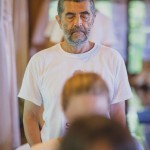“I am in pain! It hurts so much I cannot get up in the morning, I cannot live a normal life”, you may hear this on a daily basis as more than one person out of ten is constantly experiencing chronic pain (this is if we generalise based on the research made by National Institutes of Health in the USA, and assume the rest of the world’s population is in the similar pain conditions).
 Alejandra Rodrigues Agudo has shared how mindfulness practice has helped her deal with pain: “I just observed the pain and it dissolved. It is similar to when your legs get numb. If you react to that, it will be super painful, but once you observe it and realize that it will end at a certain point, you take it easier. I used to think pain will always be with me, but once I started to see it through impermanence, this is when I saw it coming and going, and it changed my whole perception.”
Alejandra Rodrigues Agudo has shared how mindfulness practice has helped her deal with pain: “I just observed the pain and it dissolved. It is similar to when your legs get numb. If you react to that, it will be super painful, but once you observe it and realize that it will end at a certain point, you take it easier. I used to think pain will always be with me, but once I started to see it through impermanence, this is when I saw it coming and going, and it changed my whole perception.”
Nowadays more and more people are turning to complementary health approaches, such as yoga, tai chi, massage therapy, and meditation. A lot has been shared on the benefits of such practices, and today we would like to suggest meditation as a remedy for daily pain. Why will it work?
Relaxation. Very often pain is created by tension in a certain part of the body that has been hurt and needs to heal. However, the tension that we create trying to protect this spot does not let it heal properly. Moreover, this tension can build up pain around, overtiring the muscles and creating an imbalance in the body.
Breathing. According to Vidyamala Burch, co-founder of Breathworks, ‘pain is the label for a flow of sensations. When we begin to really feel into it, we will notice that not in all moments pain is the same.’ She uses breathing and mindfulness techniques to help patients ease their chronic pain. Simply observing your breath and doing breathing exercise can be powerful tools.
Acceptance. Vidyamala also suggests a simple exercise to her patients. There will be two colors of pillows, say a red one symbolizes pain, and a blue one symbolizes all the emotions caused by pain. One patient will sit on a chair and place the red pillow on his lap, and the others will come around and add the emotions and frustrations they have experienced because of pain, and add a blue pillow each. When you end up seeing that your actual physical pain is only ten percent of the suffering, you start accepting the physical sensation and working towards ending those emotions through mindfulness and observation.
Stop resisting. When we no longer just resist, we start to notice more pleasant experiences – the freshness of the air, the singing of birds, etc. which broadens our awareness. We allow the pain to be there, and the pleasure to be there, and we feel and see in their changing nature.
Empathy. When we expand awareness to include others and the world around you, into your experience, you become more empathic. We are all just a mixture of pain and pleasure. Cultivation of compassion towards self and others really helps to understand the nature of pain.


